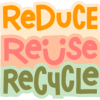Recycling plastic helps create new products, such as fabrics, carpets, and containers. When done properly, this process not only reduces the need for new raw materials but also conserves natural resources and lowers energy consumption. Additionally, by reusing plastic, we minimize waste and lessen the environmental impact of plastic production. As a result, the recycling process plays a crucial role in reducing both environmental harm and the demand for virgin materials, ultimately promoting sustainability.. This contributes to a more sustainable future by reducing reliance on virgin plastic and promoting the efficient use of resources.

![]()





